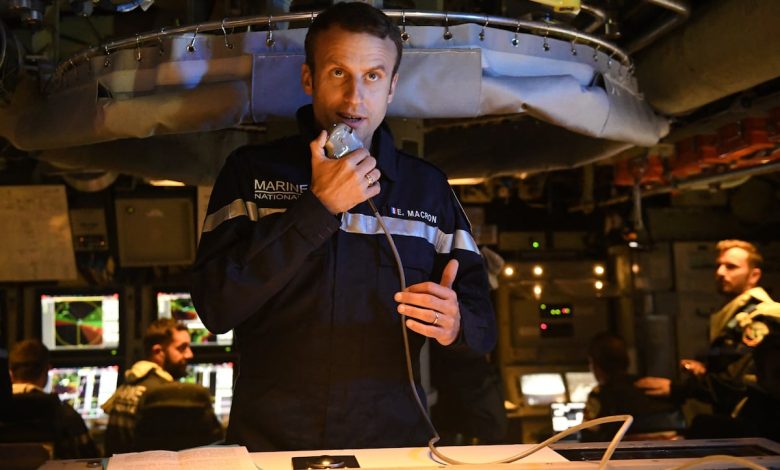France updates submarine-launched nuclear missile amid arms race

PARIS — France introduced a modernized version of its M51 submarine-launched strategic ballistic missile, a “major milestone” in the modernization of the country’s ocean-based nuclear deterrent, the Armed Forces Ministry said on Tuesday.
The third and latest version of the M51 has new nuclear warheads as well as improved range, accuracy and capability to penetrate enemy defenses, the ministry said in an emailed statement. The M51.3 will be deployed aboard France’s four Le Triomphant nuclear-powered ballistic missile submarines.
“The M51.3 ensures the continued credibility of the ocean-based component in the face of evolving enemy missile defenses,” the ministry said.
The M51 update comes amid what the Stockholm International Peace Research Institute in June described as a dangerous new nuclear arms race, with nearly all nuclear-armed states working to upgrade existing weapons and add newer versions.
As potential adversaries such as Russia modernize anti-ballistic missile capabilities, older missile designs could be at great risk of being intercepted. That in turn could diminish France’s ability to guarantee a credible second-strike capability, hurting its nuclear deterrence posture.
Armed Forces Minister Catherine Vautrin signed the operational commissioning of the M51.3 missile on Friday.
“This achievement embodies a major ambition of the 2024-2030 Military Programming Law: to accelerate the modernization of our capabilities and ensure the long-term credibility of our deterrence, the sovereign pillar of our security,” Vautrin said in a social media post.
The upgraded missile also signals France’s determination to maintain what it calls strategic autonomy within NATO. The country keeps its nuclear forces separate from the alliance’s command-and-control structure and decision-making process, though France and the U.K. in July agreed to potentially coordinate their respective deterrents.
The M51.3 program was overseen by France’s Directorate General for Armament, with the new TNO-2 warhead developed by France’s Commissariat for Atomic Energy, and with ArianeGroup in charge of missile design and propulsion.
The M51 missile has an intercontinental range and carries multiple nuclear warheads, according to the ministry. Each of France’s ballistic missile submarines is equipped with 16 of the missiles, which consist of a solid-propellant three-stage launcher with a weight of more than 50 metric tons and a length of 12 meters, according to ArianeGroup.
While the exact range of the missile is undisclosed, ArianeGroup says the M51 reaches an altitude of more than 2,000 kilometers before reentering the atmosphere at speed of Mach 20, carrying its payload over a distance of “several thousand kilometers.”
The M51.3 is estimated to have a range of more than 9,500 kilometers, compared to more than 9,000 kilometers for the previous iteration, according to the Bulletin of the Atomic Scientists.
The missile carries four to six multiple independently-targetable reentry vehicles or MIRVs, each with a yield believed to be 100 kilotons, according to the Bulletin. For each warhead, that would be more than six times the yield of the nuclear bomb dropped over Hiroshima in August 1945.
Work on the M51.3 started in 2014, while development of the TNO-2 warhead started in 2013, according to the Armed Forces Ministry. ArianeGroup and the DGA completed the first test flight of the M51.3 missile from the Biscarrosse launch site in southwestern France in November 2023.
The first version of the M51 ballistic missile became operational in 2010, and the DGA in August tasked ArianeGroup with development of the future M51.4 version.
France is also working to replace the Le Triomphant-class submarines starting in the 2030s as part of its nuclear modernization, with Naval Group cutting the first steel for the so-called SNLE 3G program in March last year. France expects to operate the next-generation submarines for nuclear deterrence until the end of the 2080s.
As well as updating the ocean-based nuclear-deterrence component, France is working on the air-launched ASN4G hypersonic missile to replace the ASMPA nuclear cruise missile carried by the Rafale fighter jet. The new missile is to be integrated on the future F5 standard of the Rafale.
The country is counting on the Future Combat Air System, the French-German-Spanish project marred by infighting between Dassault Aviation and Airbus, to provide the future airborne component of its nuclear deterrence. France has said its requirements for the FCAS aircraft include being able to carry a nuclear weapon and operate from an aircraft carrier.
Rudy Ruitenberg is a Europe correspondent for Defense News. He started his career at Bloomberg News and has experience reporting on technology, commodity markets and politics.







